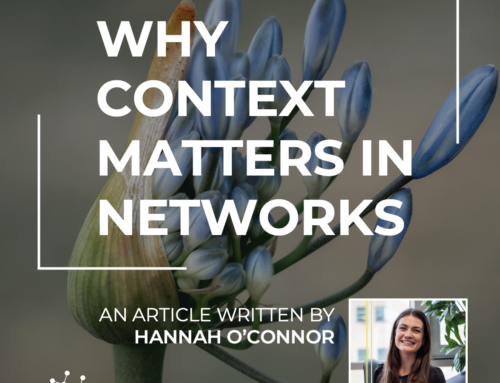FROM OUR CEO
Four Objections Leaders Have to Work With the Right People During Change
April 9th, 2025 | From our CEO

In change, some people matter more…their buy-in and support determine success. The challenge is that leaders rarely know who those people are. These sense makers/catalysts are hidden in informal networks.
In a time where it is vital to do more with less, this is still a widely overlooked area for change. In change, leaders also request efficiency.
Still…they either:
- Have a desire to communicate visibly through e-mails, intranet, posters, etc.
Mantra: See, I am doing something!
- Cascade information through the leadership ranks.
Mantra: See how powerful I am!
None of it works.
This is what works: Conversations with the people others look to when they make sense of things. Here are four objections we hear from leaders, and what to answer.
Objection 1: “I will just communicate top-down through the ranks”
~90% of your people look to only 3% of colleagues when they make sense of things.
Leaders – including people managers – on average make up 10-12% of an organization and are only looked to by 50% when making sense of things.
But what? Does that mean that leaders are not as impactful as I believe? No, they are important. They need to role model the change and communicate it with one voice, but when people decide if they should adopt and support the change, they look to their peers – the 3%.
Objection 2: “Yes, but I want to impact 100%”
Support and adoption from 100% is of course desirable. However, the reality is that you have people in the peripheries of your organization where it does not financially make sense to invest money and effort in them.
In organizations, some people have signed out.
Accept that as fact and use your time and resources on someone more impactful. A totally disconnected employee impacts no one (zero!), whereas someone more liked in the networks can impact the mood and opinion of 70-80 colleagues.
Objection 3: “Why conversations…I love e-mail!”
Change would be so much more efficient if we could just send an e-mail, make an update on the intranet, or put up a poster, and then have people change. I hate to break it to you, but it does not work like that. When it comes to change people want face-to-face communication. Preferably through a 1:1 conversation, which is 34x more impactful than sending an e-mail or other forms of digital communication that you might settle for. If you can’t do 1:1, then go for a group meeting or a town hall. Allow two-way communication, so people feel heard and seen.
Objection 4: “I do not have time to talk with people”
I promise you that you do not have the time NOT to talk with people. Leaders often hide from the people. Those who don’t want to get their hands dirty and talk to people are not succeeding. The worst thing you can do is to hire an outside consulting company to do the work for you. You know who I am talking about. Change by representation does not work! Like at all. So, find the time, or I hereby call on you to resign as a leader. You are only a leader by name anyway.
What does work – just to avoid any confusion – is working with a skilled expert who can guide you on your journey.
I am happy to help…
If you face other objections to working with the right people regarding change, then please let me know. I believe I have faced all objections once or twice over the past 17 years. If I cannot help, then I am sure one of the many members of our Innovisor community can help, and I will be happy to connect them with you.
In Innovisor, we want YOU to succeed with change. We work as your wing person to ensure you get safely to your destination. We deliver change analytics and executive coaching. We do not sugarcoat to stay friends with you.
FROM OUR CEO
Four Objections Leaders Have to Work With the Right People During Change
April 9th, 2025 | From our CEO

In change, some people matter more…their buy-in and support determine success. The challenge is that leaders rarely know who those people are. These sense makers/catalysts are hidden in informal networks.
In a time where it is vital to do more with less, this is still a widely overlooked area for change. In change, leaders also request efficiency.
Still…they either:
- Have a desire to communicate visibly through e-mails, intranet, posters, etc.
Mantra: See, I am doing something!
- Cascade information through the leadership ranks.
Mantra: See how powerful I am!
None of it works.
This is what works: Conversations with the people others look to when they make sense of things. Here are four objections we hear from leaders, and what to answer.
Objection 1: “I will just communicate top-down through the ranks”
~90% of your people look to only 3% of colleagues when they make sense of things.
Leaders – including people managers – on average make up 10-12% of an organization and are only looked to by 50% when making sense of things.
But what? Does that mean that leaders are not as impactful as I believe? No, they are important. They need to role model the change and communicate it with one voice, but when people decide if they should adopt and support the change, they look to their peers – the 3%.
Objection 2: “Yes, but I want to impact 100%”
Support and adoption from 100% is of course desirable. However, the reality is that you have people in the peripheries of your organization where it does not financially make sense to invest money and effort in them.
In organizations, some people have signed out.
Accept that as fact and use your time and resources on someone more impactful. A totally disconnected employee impacts no one (zero!), whereas someone more liked in the networks can impact the mood and opinion of 70-80 colleagues.
Objection 3: “Why conversations…I love e-mail!”
Change would be so much more efficient if we could just send an e-mail, make an update on the intranet, or put up a poster, and then have people change. I hate to break it to you, but it does not work like that. When it comes to change people want face-to-face communication. Preferably through a 1:1 conversation, which is 34x more impactful than sending an e-mail or other forms of digital communication that you might settle for. If you can’t do 1:1, then go for a group meeting or a town hall. Allow two-way communication, so people feel heard and seen.
Objection 4: “I do not have time to talk with people”
I promise you that you do not have the time NOT to talk with people. Leaders often hide from the people. Those who don’t want to get their hands dirty and talk to people are not succeeding. The worst thing you can do is to hire an outside consulting company to do the work for you. You know who I am talking about. Change by representation does not work! Like at all. So, find the time, or I hereby call on you to resign as a leader. You are only a leader by name anyway.
What does work – just to avoid any confusion – is working with a skilled expert who can guide you on your journey.
I am happy to help…
If you face other objections to working with the right people regarding change, then please let me know. I believe I have faced all objections once or twice over the past 17 years. If I cannot help, then I am sure one of the many members of our Innovisor community can help, and I will be happy to connect them with you.
In Innovisor, we want YOU to succeed with change. We work as your wing person to ensure you get safely to your destination. We deliver change analytics and executive coaching. We do not sugarcoat to stay friends with you.
Related articles
Share article
Share article









